Family name: Haemodoraceae R. Brown
Synonym(s): Conostylidaceae Takht.; Wachendorfiaceae Herb.; Xiphidiaceae Dumort.
Common name(s): bloodwort family
*Number of genera/species: 14/102
List of genera records in GRIN-Global
fruit or seed
Fruit dehiscentdehiscent:
(v. dehisce) splitting open at maturity to release contents (of a fruit)
 , loculicidalloculicidal:
, loculicidalloculicidal:
type of capsular dehiscence, opening longitudinally through the locules (compare septicidal)
 , septicidalsepticidal:
, septicidalsepticidal:
type of capsular dehiscence, opening longitudinally by separating between the septa of adjacent carpels
 or poricidalporicidal:
or poricidalporicidal:
type of capsular dehiscence, fruit opening by pores or flaps (often near the top)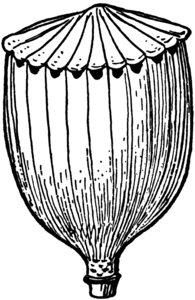 capsulecapsule:
capsulecapsule:
a dry, dehiscent fruit formed by two or more carpels
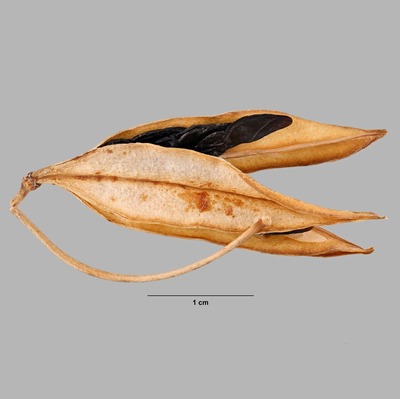 , rarely indehiscentindehiscent:
, rarely indehiscentindehiscent:
not opening on its own, as in a fruit
 drupedrupe:
drupedrupe:
(indehiscent drupe) a fleshy, indehiscent fruit with one more hard pits enclosing seeds; (dehiscent drupe) a fruit with a dry or fibrous to fleshy or leathery outer husk that early to tardily breaks apart (or opens), exposing one or more nutlike pits enclosing the seeds
 (Macropidia), 3–15 mm long, globoseglobose:
(Macropidia), 3–15 mm long, globoseglobose:
3D shape—more or less spherical
 to trigonoustrigonous:
to trigonoustrigonous:
3D shape—having three faces that meet at distinct angles; triangular in outline
, 3-angled in transectiontransection:
a cross section; representing a plane made by cutting across an organ at a right angle to its length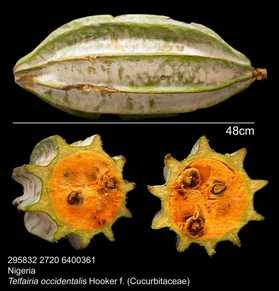 , sometimes beakedbeaked:
, sometimes beakedbeaked:
a usually firm, terminal appendage, sometimes tapered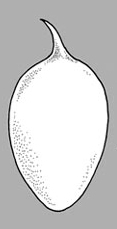 or crowned by persistent perianthperianth:
or crowned by persistent perianthperianth:
collective term for calyx and corolla of a flower
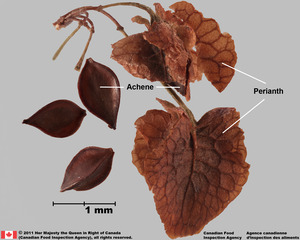 or tepalstepals:
or tepalstepals:
a member of the perianth, when it cannot be differentiated into a calyx and corolla
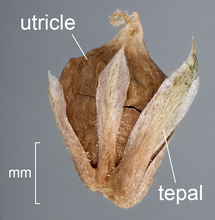 , many seeded except if drupedrupe:
, many seeded except if drupedrupe:
(indehiscent drupe) a fleshy, indehiscent fruit with one more hard pits enclosing seeds; (dehiscent drupe) a fruit with a dry or fibrous to fleshy or leathery outer husk that early to tardily breaks apart (or opens), exposing one or more nutlike pits enclosing the seeds
 then one seeded. Pericarppericarp:
then one seeded. Pericarppericarp:
fruit wall or fruit coat
black, brown, or purple, shinyshiny:
uniformly reflecting a high proportion of incident light at all angles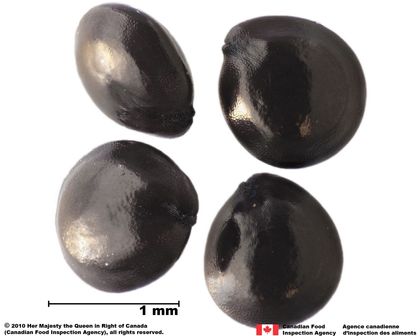 , smooth or wrinkledwrinkled:
, smooth or wrinkledwrinkled:
surface relief—shallow, irregular folds and furrows covering the surface; appearing overall though crumpled and then spread out . Pericarppericarp:
. Pericarppericarp:
fruit wall or fruit coat
glandularglandular:
surface relief—covered with small, raised secretory glands, regular or irregularly shaped, translucent or opaque, and maybe distinctly colored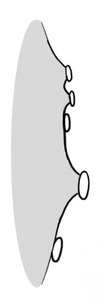 and hairy in Wachendorfia. In Macropidia fuliginosa, fruit dehisces into three drupe-like mericarpsmericarps:
and hairy in Wachendorfia. In Macropidia fuliginosa, fruit dehisces into three drupe-like mericarpsmericarps:
a one-seeded section (carpel) of a schizocarp, as in Apiaceae fruits (compare schizocarp)
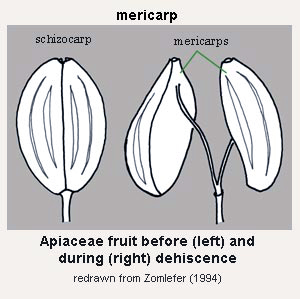 .
.
Seed globoseglobose:
3D shape—more or less spherical
 to lens-shapedlens-shaped:
to lens-shapedlens-shaped:
2D shape—round and flattened with two curved (convex) surfaces
, flattened in transectiontransection:
a cross section; representing a plane made by cutting across an organ at a right angle to its length , 0.5–2 mm long. Seed coat black, brown, red, or white, sometimes transparent, dulldull:
, 0.5–2 mm long. Seed coat black, brown, red, or white, sometimes transparent, dulldull:
reflecting only a low proportion of incident light, with no apparent sheen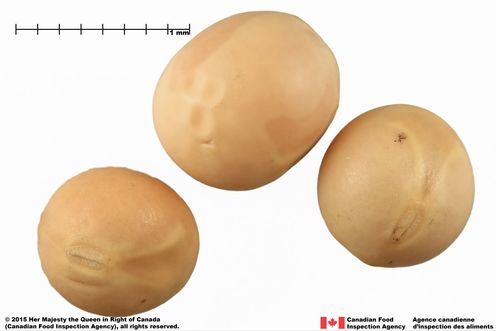 , leatheryleathery:
, leatheryleathery:
texture—moderately thick, tough, and very pliable
, smooth or variously sculptured, pubescentpubescent:
surface relief—bearing hairs
in Pyrrorhiza and Wachendorfia. Seeds winged in Dilatris, Haemodorum, Lachnanthes, andSchiekia. Wachendorfia seeds with carunclescaruncles:
a localized outgrowth of the seed coat near the hilum of the seed; it functions as an elaiosome
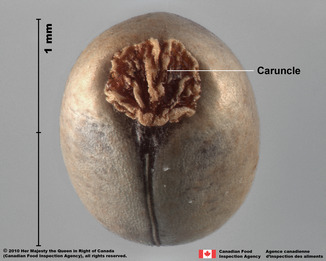 and water-soluble violet-purple pigment in the inner seed coat.
and water-soluble violet-purple pigment in the inner seed coat.
Embryo in some genera globoseglobose:
3D shape—more or less spherical
 to kidney shapedkidney shaped:
to kidney shapedkidney shaped:
2D shape—broadly elongate and with one margin convex and the opposite side concave, each end bluntly rounded and laterallateral:
and laterallateral:
(of embryo) embryo lies along the side of the seed, generally towards one end; of, at, or from the side; in grasses, can refer to the sides adjacent to the dorsal and ventral sides
, and other genera rudimentaryrudimentary:
(of embryo) embryo is small and fills less than a quarter of the seed and can be variable in shapes, such as linear, spatulate, or oval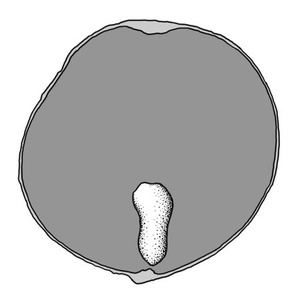 , curvedcurved:
, curvedcurved:
(of embryo) linear embryo is curved into an arch or horseshoe with the ends far apart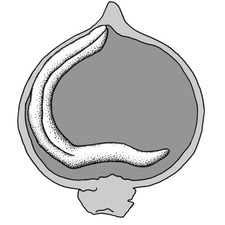 , and capping micropylar end of endospermendosperm:
, and capping micropylar end of endospermendosperm:
nutritive starch- and oil-containing tissue present in many seeds
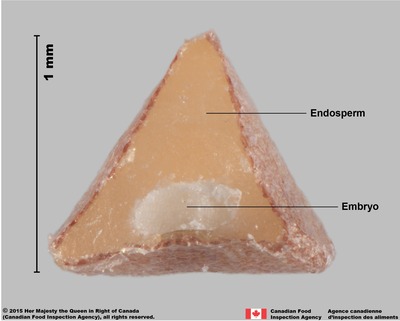 . Endospermendosperm:
. Endospermendosperm:
nutritive starch- and oil-containing tissue present in many seeds
 copious, fleshyfleshy:
copious, fleshyfleshy:
texture—fairly firm and dense, juicy or at least moist, and easily cut
, hard, or cartilaginouscartilaginous:
texture—firm, dense, tough, somewhat pliable, and resilient, like cartilage
, and more or less transparent.
In the weedy species, Lachnanthes caroliniana (Lam.) Dandy, capsulescapsules:
a dry, dehiscent fruit formed by two or more carpels
 are globoseglobose:
are globoseglobose:
3D shape—more or less spherical
 or oblateoblate:
or oblateoblate:
depressed globose
, 3–5 mm in diam, and 3-lobed. Seeds are reddish-brown, 2.5–3 mm diam., discoiddiscoid:
3D shape—resembling a disc
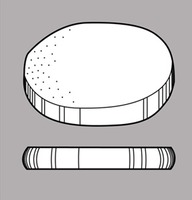 , minutely scabratescabrate:
, minutely scabratescabrate:
surface relief—rough, having small, stout, stiff, more or less acute protrusions
with hilumhilum:
on seeds, the scar indicating where the funiculus was attached; on grass caryopses, the scar visible on the outer caryopsis surface revealing where the seed is attached on the inner fruit wall surface; or in Asteraceae cypselae, the scar visible on the pericarp revealing where the fruit was attached to the receptacle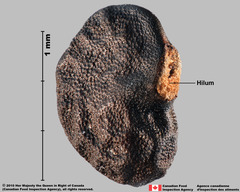 positioned centrally on the concave side.
positioned centrally on the concave side.
| Fruit | |
| Type | capsule, rarely drupe |
| Size range | 3–15 mm long |
| Shape(s) | globose, ovoidovoid: 3D shape—ovate  , trigonoustrigonous: , trigonoustrigonous:3D shape—having three faces that meet at distinct angles; triangular in outline , oblongoblong: 2D shape—much longer than broad with nearly parallel sides, corners are rounded  , ellipsoid , ellipsoid |
| Surface relief | smooth or wrinkled |
| Color(s) | black, purple, brown |
| Unique features | Dark colored oblongoblong: 2D shape—much longer than broad with nearly parallel sides, corners are rounded  ,-angled in transectiontransection: ,-angled in transectiontransection:a cross section; representing a plane made by cutting across an organ at a right angle to its length  with smooth or wrinkledwrinkled: with smooth or wrinkledwrinkled:surface relief—shallow, irregular folds and furrows covering the surface; appearing overall though crumpled and then spread out  pericarppericarp: pericarppericarp:fruit wall or fruit coat . |
| Seed | |
| Size range | 0.5–2 mm long |
| Shape(s) | globose, ellipsoidellipsoid: 3D shape—elliptic , ovoidovoid: 3D shape—ovate  , curvedcurved: , curvedcurved:(of embryo) linear embryo is curved into an arch or horseshoe with the ends far apart  , reniformreniform: , reniformreniform:2D or 3D shape—kidney-shaped  , lens-shaped , lens-shaped |
| Surface relief | smooth, wrinkledwrinkled: surface relief—shallow, irregular folds and furrows covering the surface; appearing overall though crumpled and then spread out  , reticulatereticulate: , reticulatereticulate:surface relief—netted, raised walls or concave grooves forming a net-like surface pattern with flat, concave, or convex interspaces  , ribbedribbed: , ribbedribbed:surface relief—wide, prominent, linear ridges that are generally rounded and longitudinally situated on the surface 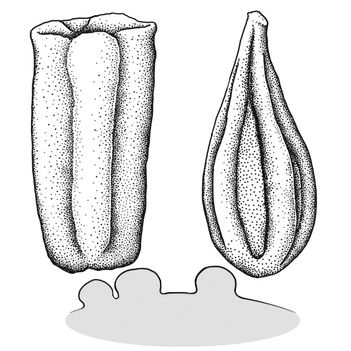 , ridgedridged: , ridgedridged:surface relief—raised, thick ridges, sharp edged or rounded, usually in a series that may cover the entire surface 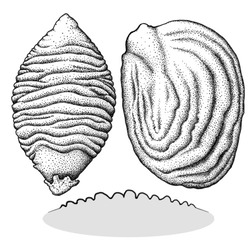 , papillatepapillate: , papillatepapillate:surface relief—bearing minute, distinct, broad-based projections, tapering to a rounded apex  , pittedpitted: , pittedpitted:surface relief—surface with small depressions in which the areas between the hollows do not take on the appearance of a true reticular net  , groovedgrooved: , groovedgrooved:surface relief—linear depressions that may be single or form a series of grooves over the surface  , wartywarty: , wartywarty:surface relief—distinct, rounded projections that are large relative to the fruit size; tuberculate, verrucose 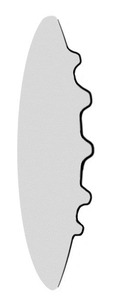 , punctate , punctate |
| Color(s) | black, brown, red, white |
| Other | |
| Embryo | in some genera globoseglobose: 3D shape—more or less spherical  to kidney shapedkidney shaped: to kidney shapedkidney shaped:2D shape—broadly elongate and with one margin convex and the opposite side concave, each end bluntly rounded  and laterallateral: and laterallateral:(of embryo) embryo lies along the side of the seed, generally towards one end; of, at, or from the side; in grasses, can refer to the sides adjacent to the dorsal and ventral sides , and other genera rudimentaryrudimentary: (of embryo) embryo is small and fills less than a quarter of the seed and can be variable in shapes, such as linear, spatulate, or oval  , curvedcurved: , curvedcurved:(of embryo) linear embryo is curved into an arch or horseshoe with the ends far apart  , and capping micropylar end of endospermendosperm: , and capping micropylar end of endospermendosperm:nutritive starch- and oil-containing tissue present in many seeds  . . |
| Nutritive tissuenutritive tissue: tissue within the seeds that nourishes the developing embryo; such as endosperm, perisperm, or chalazosperm in angiosperms; megagametophyte in gymnosperms |
endosperm endosperm: nutritive starch- and oil-containing tissue present in many seeds  copious, fleshyfleshy: copious, fleshyfleshy:texture—fairly firm and dense, juicy or at least moist, and easily cut , hard, or cartilaginouscartilaginous: texture—firm, dense, tough, somewhat pliable, and resilient, like cartilage , and more or less transparent |
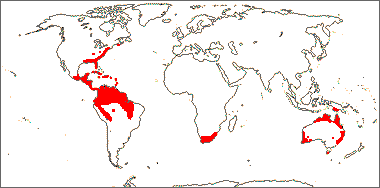
Distribution map courtesy of Angiosperm Phylogeny Website.
Baskin and Baskin 2021Baskin and Baskin 2021:
Baskin C and Baskin J. 2021. Relationship of the lateral embryo (in grasses) to other monocot embryos: A status up-grade. Seed Science Research 31 (3): 199-210. doi:10.1017/S0960258521000209; Berryberry:
an indehiscent, fleshy fruit with one or a few to many seeds. The flesh may be homogenous throughout. Or, if the outer part is hard, firm, or leathery, referred to as an hesperidium. Septa are present in some, and the seeds may be arillate or with a fleshy testa. et al. 1995; Dahlgren et al. 1985Dahlgren et al. 1985:
et al. 1995; Dahlgren et al. 1985Dahlgren et al. 1985:
Dahlgren RMT, Clifford HT, and Yeo PF. 1985. The families of the monocotyledons: structure, evolution, and taxonomy. Springer-Verlag, Berlin. 520 pp.; Davidse et al. 2009–2018Davidse et al. 2009–2018:
Davidse GM, Sousa Sánchez M, Knapp S. and Chiang Cabrera F, eds. 2009–2018. Flora Mesoamericana. Missouri Botanical Garden, St. Louis, MO. Accessed: January–April 2024. URL: http://legacy.tropicos.org/Project/FM; Flora of Australia 2021+Flora of Australia 2021+:
Flora of Australia. Australian Biological Resources Study, Canberra. Accessed January 2021–March 2024. URL: http://www.ausflora.org.au; Flora of North America Editorial Committee 1993+Flora of North America Editorial Committee 1993+:
Flora of North America Editorial Committee, eds. 1993+. Flora of North America North of Mexico [Online]. 22+ vols. Flora of North America Association, New York and Oxford. Accessed January-March 2024. URL: http://beta.floranorthamerica.org.; Kirkbride et al. 2006Kirkbride et al. 2006:
Kirkbride JH, Jr, Gunn CR, and Dallwitz MJ. 2006. Family guide for fruits and seeds, vers. 1.0. Accessed September 2020-January 2022. URL: https://nt.ars-grin.gov/seedsfruits/keys/frsdfam/index.cfm .; Kubitzki et al. 1990+Kubitzki et al. 1990+:
Kubitzki K et al., eds. 1990+. The families and genera of vascular plants. 7+ vols. Berlin etc.; Stevenson and Loconte 1995Stevenson and Loconte 1995:
Stevenson DW and Loconte H. 1995. A cladistic analysis of monocot families. In: Rudall PJ, Cribb PJ, Cutler DF, and Humphries CJ, eds. Monocotyledons: Systematics and Evolution. Royal Botanic Gardens, Kew.; Takhtajan 2009Takhtajan 2009:
Takhtajan A. 2009. Flowering plants: Second edition. Springer Nature, Switzerland. 871 pp.; Thiele and Adams 2014Thiele and Adams 2014:
Thiele KR and Adams LG. 2014. Families of Flowering Plants of Australia. Accessed January-December 2021. URL: https://keys.lucidcentral.org/keys/v3/FFPA/key/FFPA/Media/Html/index.htm; Thiselton-Dyer 1896-1897Thiselton-Dyer 1896-1897:
Thiselton-Dyer WT. 1896-1897. Flora capensis: being a systematic description of the plants of the Cape colony, Caffraria, amp; Port Natal (and neighbouring territories). Vol. 6. L. Reeve, Kent UK. 563 pp. https://doi.org/10.5962/bhl.title.821
*The number of genera and species is based on Christenhusz and Byng 2016Christenhusz and Byng 2016:
Christenhusz MJM and Byng JW. 2016. The number of known plant species in the world and its annual increase. Phytotaxa 261 (3): 201-217. https://doi.org/10.11646/phytotaxa.261.3.1, which may differ from the number of genera in GRIN-Global.